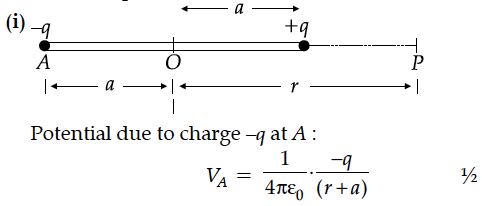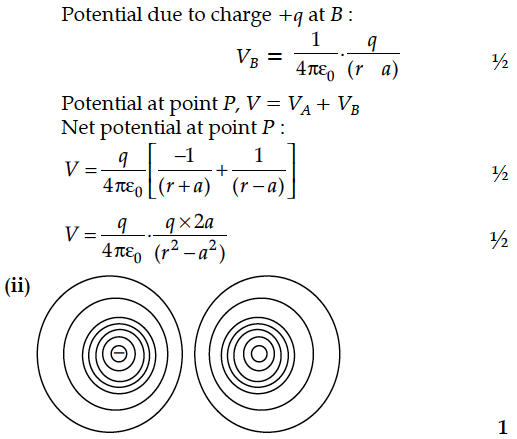(i) Derive the expression for the electric potential due to an electric dipole at a point on its axial line.
(ii) Depict the equipotential surface due to electric dipole.
(ii) Depict the equipotential surface due to electric dipole.


Obtain the expression for the potential due to an electric dipole of dipole moment p at a point ‘d’ on the axial line.
Why are electric field lines perpendicular at a point on an equipotential surface of a conductor ?
Draw a plot showing the variation of (i) electric field (E) and (ii) electric potential (V) with distance r due to a point charge Q.
For any charge configuration, equipotential surface through a point is normal to the electric field. Justify.
Choose the SI unit of electric potential energy :
(a) Joule
(b) Coulomb
(c) Newton per coulomb
(d) Erg
In which of the following forms is the energy stored in a capacitor?
(a) Charge
(b) Potential
(c) Capacitance
(d) Electric field
An electron is accelerated through a potential difference V. Write the expression for its final speed, if it was initially at rest.
An inductor L of inductance is connected in series with a bulb B and an ac source. How would brightness of the bulb change when
(i) number of turns in the inductor is reduced,
(ii) an iron rod is inserted in the inductor and
(iii) a capacitor of reactance is inserted in series in the circuit. Justify your answer in each case.
What is relaxation time ? Derive an expression for resistivity of a wire in terms of number density of free electrons and relaxation time.
The figure shows a series LCR circuit with L = 5.0 H, C = 80 µF, R = 40 Ω connected to a variable frequency of 240 V source. Calculate
Two cells of emfs E₁ & E₂ and internal resistances r₁ & r₂ respectively are connected in parallel. Obtain expressions for the equivalent.
(i) resistance and
(ii) emf of the combination
A source of ac voltage V = V₀ sin ωt, is connected across a pure inductor of inductance L. Derive the expressions for the instantaneous current in the circuit. Show that average power dissipated in the circuit is zero.
An electric dipole is placed in a uniform electric field.
(i) Show that no translatory force acts on it.
(ii) Derive an expression for the torque acting on it.
(iii) Find work done in rotating the dipole through 180°.
A circuit containing an 80 mH inductor and a 250 µF capacitor in series connected to a 240 V,100 rad/s supply. The resistance of the circuit is negligible.
(i) Obtain rms value of current.
(ii) What is the total average power consumed by the circuit ?
